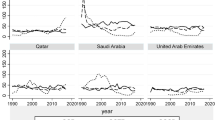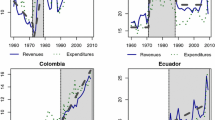Abstract
We assessed the sustainability of fiscal policy in the 28 European Union countries over the 1980-2015 years. Panel unit root tests in the presence of cross-sectional dependence showed that government revenues, expenditures, the primary balance, and debt were non-stationary series. However, cointegration tests reveled that a long-run relationship exists between government revenues and expenditures as well as between government primary deficit and debt. The results of causality tests were in line with the neutrality hypothesis: government revenues do not cause the expenditures, and vice versa. Furthermore, mixture models analyses indicated the presence of three homogeneous clusters, one of which included Portugal, Ireland, Italy, Greece, and Spain (PIIGS), whose coefficient of 0.68 indicates the absence of sustainability, since government expenditures grow faster than revenues.
Similar content being viewed by others
References
Afonso, A. (2005). Fiscal sustainability: The unpleasant European case. FinanzArchiv, 61(1), 19–44.
Afonso, A., & Rault, C. (2010). What do we really know about fiscal sustainability in the EU? A panel data diagnostic. Review of World Economics, 145, 731–755. https://doi.org/10.1007/s10290-009-0034-1.
Afonso, A., & Jalles, J. T. (2015). How does fiscal policy affect investment? Evidence from a Large Panel. International Journal of Finance & Economics, 20(4), 310–327. https://doi.org/10.1002/ijfe.1518.
Ahmad, A. H., & Fanelli, S. (2014). Fiscal sustainability in the euro-zone: Is there a role for euro-bonds? Atlantic Economic Journal, 42, 291–303. https://doi.org/10.1007/s11293-014-9416-4.
Artis M., Marcellino M., (1998). Fiscal solvency and fiscal forecasting in Europe. IGIER Working Papers, 142, https://ideas.repec.org/p/igi/igierp/142.html.
Baghestani, H., & McNown, R. (1994). Do revenues or expenditures respond to budgetary disequilibria? Southern Economic Journal, 61, 311–322.
Baltagi, B. H., Feng, Q., & Kao, C. (2012). A Lagrange multiplier test for cross-sectional dependence in a fixed effects panel data model. Journal of Econometrics, 170, 164–177.
Bohn, H. (2007). Are stationarity and cointegration restrictions really necessary for the intertemporal budget constraint? Journal of Monetary Economics, 54, 1837–1847. https://doi.org/10.1016/j.jmoneco.2006.12.012.
Bohn H., (2005). The Sustainability of Fiscal Policy in the United States, CESifo Working Paper Series, 1446, https://ideas.repec.org/p/ces/ceswps/_1446.html.
Bravo, A. B. S., & Silvestre, A. L. (2002). Intertemporal sustainability of fiscal policies: Some tests for European countries. European Journal of Political Economy, 18, 517–528.
Breusch, T. S., & Pagan, A. R. (1980). The Lagrange multiplier test and its applications to model specification in econometrics. The Review of Economic Studies, 47(1), 239–253.
Burnside, C. (2005). Fiscal sustainability in theory and practice: A handbook. Washington, DC: The World Bank.
Caporale, G. M. (1995). Bubble finance and debt sustainability: A test of the government’s intertemporal budget constraint. Applied Economics., 27, 1135–1143.
Chudik, A., & Pesaran, M. H. (2015). Large panel data models with cross-sectional dependence: A survey. In B. H. Baltagi (Ed.), The Oxford handbook of panel data (pp. 3–45). New York: Oxford University Press.
Claeys P., (2007). Sustainability of EU fiscal policies: A panel test. Institut de Recerca en Economia Aplicada – Documents de Treball, 2007/02.
Dumitrescu, E. I., & Hurlin, C. (2012). Testing for granger NonCausality in heterogeneous panels. Economic Modelling, 29(4), 1450–1460.
Eberhardt, M., & Teal, F. (2011). Econometrics for grumblers: A new look at the literature on cross-country growth empirics. Journal of Economic Surveys, 25(1), 109–155.
Esposito, M. (2015). A model for public debt sustainability and sovereign credit risk in the Eurozone. Economic Notes, 44(3), 511–529.
European Commission (1980-2015), AMECO database, http://ec.europa.eu/economy_finance/ameco/user/serie/SelectSerie.cfm.
Forte, F., & Magazzino, C. (2016). Fiscal policies in EMU countries: Strategies and empirical evidence. Journal of International Trade Law and Policy, 15, 1. https://doi.org/10.1108/JITLP-10-2015-0031.
Greiner, A., Köller, U., & Semmler, W. (2007). Debt sustainability in the European monetary union: Theory and empirical evidence for selected countries. Oxford Economic Papers, 59, 194–218. https://doi.org/10.1093/oep/gpl035.
Hakkio, C. S., & Rush, M. (1991). Is the budget deficit “too large?”. Economic Inquiry, 29, 429–445.
Hamilton, J. D., & Flavin, M. (1986). On the limitations of government borrowing: A framework for empirical testing. American Economic Review, 76(4), 808–819.
Kao, C. (1999). Spurious regression and residual-based tests for Cointegration in panel data. Journal of Econometrics, 90, 1–44.
Keynes, J. M. (1923). A tract on monetary reform. London: MacMillan.
Kollias, C., & Paleologou, S. M. (2006). Fiscal policy in the European Union: Tax and spend, spend and tax, fiscal synchronisation or institutional separation? Journal of Economic Studies, 33(2), 108–120. https://doi.org/10.1108/01443580610666064.
Izák, V. (2009). Primary balance, public debt and fiscal variables in postsocialist members of the European Union. Prague Economic Papers, 2, 114–130. https://doi.org/10.18267/j.pep.345.
Magazzino, C., Giolli, L., & Mele, M. (2015). Wagner’s law and peacock and Wiseman’s displacement effect in European Union countries: a panel data study. International Journal of Economics and Financial Issues, 5(3), 812–819.
Magazzino, C., & Lepore, F. (2015). Le politiche di bilancio nell’Eurozona: strategie ed evidenza empirica. Rivista Bancaria – Minerva Bancaria, 5-6, 103–142.
Moscone, F., & Tosetti, E. (2009). A review and comparison of tests of cross-section independence in panels. Journal of Economic Surveys, 23(3), 528–561.
Papadopoulos, A. P., & Sidiropoulos, G. P. (1999). The sustainability of fiscal policies in the European Union. International Advances in Economic Research, 5(3), 289–307.
Pedroni, P. (2004). Panel Cointegration; asymptotic and finite sample properties of pooled time series tests, with an application to the PPP hypothesis. Econometric Theory, 20, 597–625.
Pesaran, M. H. (2007). A simple panel unit root test in the presence of cross section dependence. Journal of Applied Econometrics, s.I, 22(2), 265–312.
Pesaran M.H., (2004). General diagnostic tests for cross section dependence in panels. Cambridge Working Papers in Economics, 0435, https://ideas.repec.org/p/cam/camdae/0435.html.
Teică, R. A. (2012). Analysis of the public debt sustainability in the economic and monetary union. Procedia Economics and Finance, 3, 1081–1087.
Trehan, B., & Walsh, C. E. (1991). Testing intertemporal budget constraints: Theory and applications to U.S. to Federal Budget and current account deficits. Journal of Money, Credit, and Banking, 23, 206–223.
Vanhorebeek, F., & Van Rompuy, P. (1995). Solvency and sustainability of fiscal policies in the EU. De Economist, 143(4), 457–473.
Uctum, M., & Wickens, M. (2000). Debt and deficit ceilings, and sustainability of fiscal policies: An intertemporal analysis. Oxford Bulletin of Economics and Statistics, 62(2), 197–222.
Acknowledgements
Comments from the participants at the Present and future of the EU and EMU: Debts, deficits, and related institutional designs. Conference in Honour of Francesco Forte (Rome, December 2016), as well as the participants at the 83rd International Atlantic Economic Conference (Berlin, March 22-25, 2017) are gratefully acknowledged. Moreover, we thank the anonymous referees and the editor for valuable comments and suggestions. The usual disclaimer applies.
Author information
Authors and Affiliations
Corresponding author
Rights and permissions
About this article
Cite this article
Brady, G.L., Magazzino, C. Fiscal Sustainability in the EU. Atl Econ J 46, 297–311 (2018). https://doi.org/10.1007/s11293-018-9588-4
Published:
Issue Date:
DOI: https://doi.org/10.1007/s11293-018-9588-4




